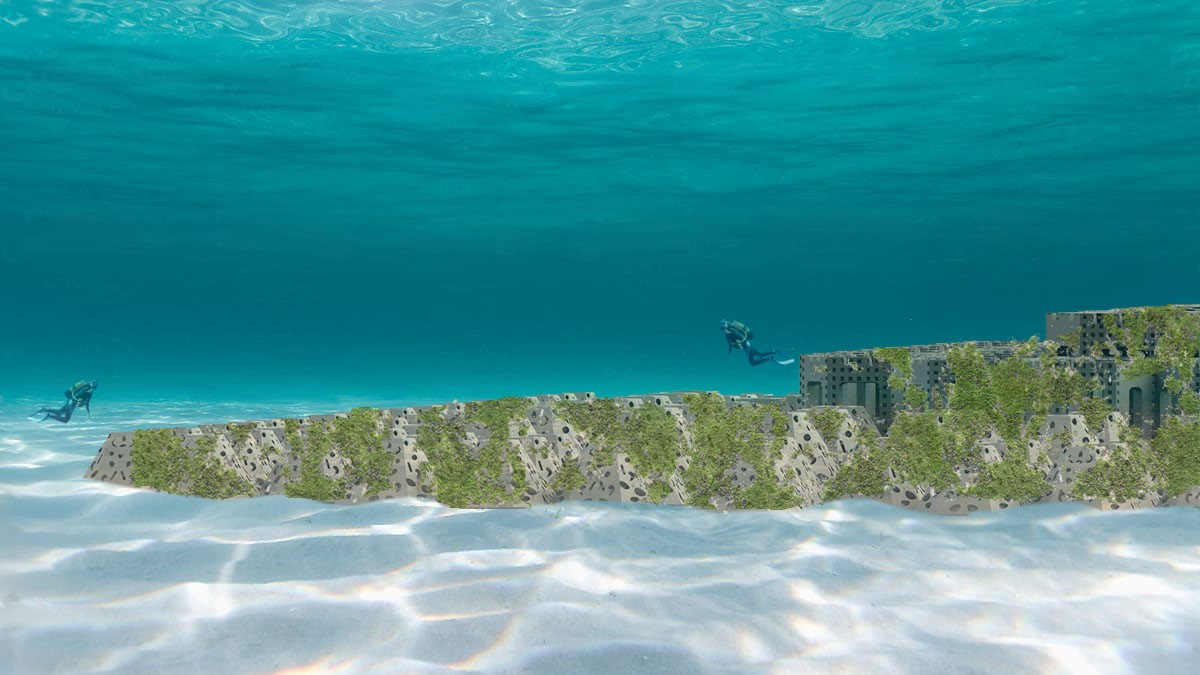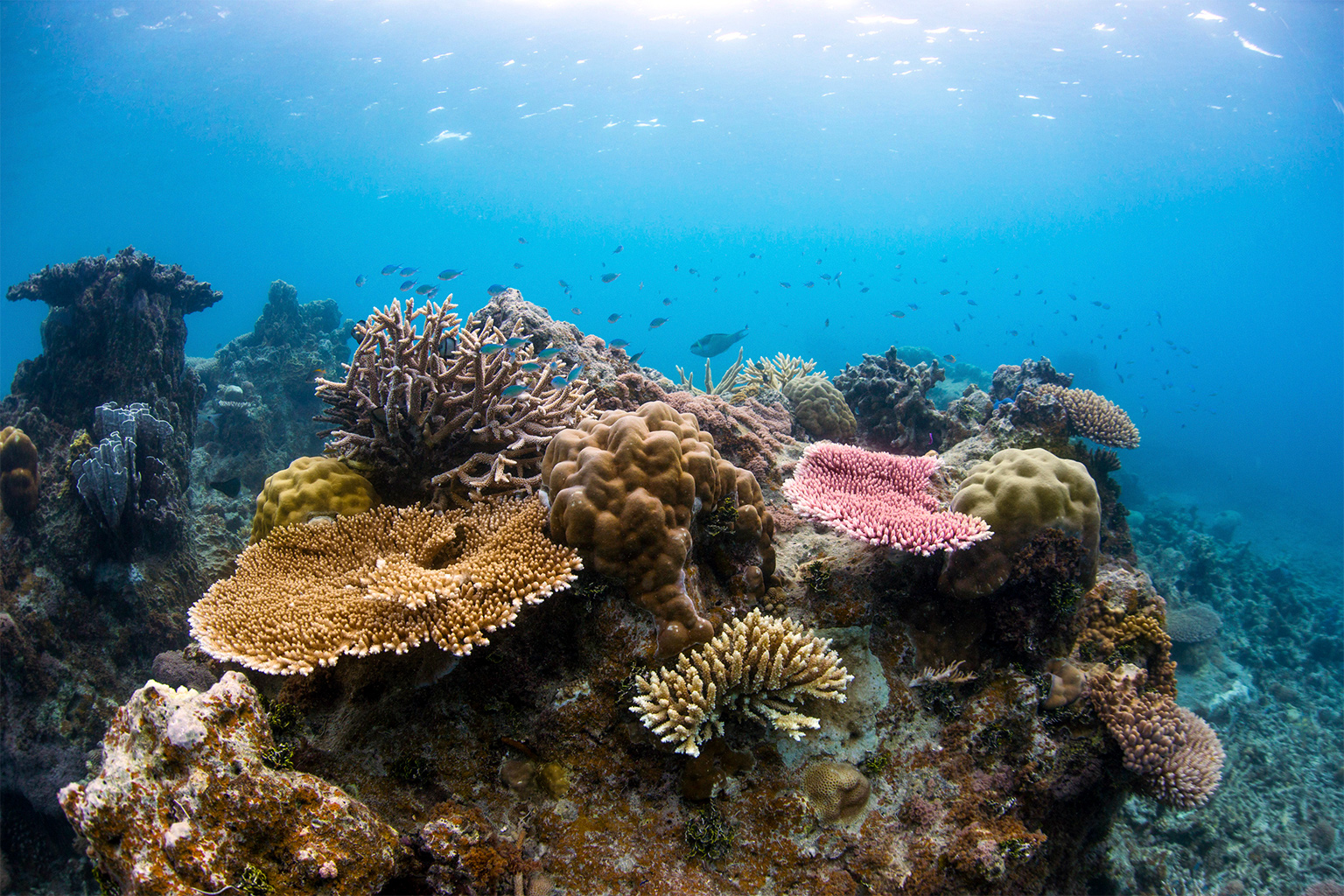From the ocean floor, a startup livestreams the rise of coral cities
Nov 10, 2021
- A Portuguese company that was forged in Southeast Asia is building an underwater city for coral in Sultan Iskandar Marine Park, Malaysia, made from food waste such as rice husks.
- It is also building a 72 km2 (28 mi2) engineered reef off Comporta, Portugal, which will cost nearly $3 million.
- Each stackable underwater city contains a Bluboxx, a console fitted with sensors to measure the salinity, temperature and acidity of the sea, with the data then livestreamed to scientists and shared with governments.
- If no action is taken to protect coral reefs, it is believed that 90% will be extinct by 2050, according to the U.N.’s Intergovernmental Panel on Climate Change.
Nestled on the ocean floor in Southeast Asia are five sensor-filled boxes that will reveal the future of coral reefs. For the past year, from their secret location, the Bluboxx project has been livestreaming data on the health of the coral reef to researchers in Southeast Asia.
While groundbreaking, these Bluboxxes are part of a grander plan: they mark the beginning of a network of engineered underwater cities that are designed to save coral. The first two cities will be launched in 2022, one in Sultan Iskandar Marine Park, Malaysia, which is home to dugongs and turtles, and the other along the Comporta coastline of Portugal.
The 72-square-kilometer (28-square-mile) Comporta reef is expected to cost 2.5 million euros ($2.9 million) and open in time for the U.N. Ocean Conference that takes place in Lisbon in 2022. While the summit serves as a clear deadline, the Blue Oasis Technology team behind the project has another deadline that it’s working toward, and which it says is more concerning: 90% of corals could go extinct by 2050 if no action is taken to protect reefs, according to a report from the U.N.’s Intergovernmental Panel on Climate Change. Coral reefs support a quarter of all marine life species, as well as half a billion people across the globe.
This grand plan for underwater coral cities came from Dutch engineer and scuba diver Jeroen van de Waal.
“There are literally dozens of startups today that have beautiful ideas, but their solutions are not scalable,” Van de Waal, founder of Blue Oasis Technology, told Mongabay in an interview. “They are very small and won’t work in many oceans because the hydrodynamics in these oceans are too wild and too strong for these small reef modules to survive.”


Van de Waal, who is accustomed to building giant underwater structures for the oil and gas industry, said he knew he could create a structure that could hold its ground in some of the wildest oceans. The first engineered reef will be launched in the Atlantic Ocean. The next will be launched in the calmer turquoise-colored waters off Malaysia.
These dramatically different locations mean that Blue Oasis Technology is able to show how the engineered underwater city can be adapted to suit both large- and small-scale projects. In Comporta, each 55-metric-ton module will be lowered into the ocean using a crane vessel, while in Sultan Iskandar Marine Park, the team will take a more low-key approach and float smaller stackable modules to the location of the new reef.
The eco building blocks can be used to mirror the original underwater landscape. If there was once a seawall or a low-level sprawling reef, the stackable modules can be used to emulate it and hopefully attract the same flora and fauna.
The scientists on the team have attempted to replicate 10,000-year-old coral reefs by creating a calcium-rich eco-friendly concrete from recycled industrial waste such as decontaminated sludge and slag. They also plan to use food waste such as rice husks in their mix.
Stacey Tighe, the marine science, strategy and policy adviser for Blue Oasis Technology, said a local approach to sourcing materials will be key.
“As we go into reef production at particular sites, we will reach out for the raw materials to the relevant industries nearby,” Tighe said. “This means that less waste needs to be exported or processed, which reduces cost and pollution, and the transport costs for the construction of the engineered reefs will be lower.”
Blue Oasis Technology will build this low-carbon backbone and then partner with organizations such as the award-winning Bahamian company Coral Vita, which grows resilient corals and can transplant them onto these engineered reefs.

While modern technology is being adopted by Blue Oasis Technology and companies such as Living Walls, which is using a 3D printer to create coral reef tiles, there is evidence to show that artificial reefs have existed for hundreds of years. In the 17th century, Japanese fishermen used to build wooden structures to increase their fish stocks, and in the U.S. in the 1830s, fishermen submerged log huts to create artificial reefs off South Carolina. The most studied historical artificial reef is the ruins of an 18th-century jetty in St. Eustatius in the Caribbean.
However, researchers found that even this 200-year-old artificial reef did not match the complexity of life on a natural coral reef.
The choice of materials used have also not always been successful.
A well-intentioned artificial reef created from 700,000 tires off Florida in 1972 resulted in a $1.6 million cleanup operation 40 years later. The coral wouldn’t grow on the rubber, and the ties connecting the tires were corroded by the salt water, causing the tires to roll around and damage the surrounding natural coral reefs.
Selina Ward from the University of Queensland, Australia, who specializes in coral reef ecology, said the complexity of the surfaces on which coral larvae settle is an amazing science. She said they like to settle on algae, which they incorporate into their skeletons, use to protect themselves against a bleaching event, and take microscopic cells from for energy.
“We are only just beginning to understand the importance of this microbiome for the health and survival of coral,” Ward said.
She said Blue Oasis Technology’s choice of using a natural reef’s calcium carbonate structure is a step in the right direction, but a lot more needs to happen to make an artificial reef successful. “You can’t paint the algae on — it’s got to make it itself. The site for the artificial reef needs to have the right temperature, current and sediment levels and it is important there is plenty of fish in the area so they can trim the algae that are inevitably going to grow first on that concrete,” she said. “Algae and coral are both looking for life and space, so they compete. Without fish, you could have a frame full of algae.”

Benjamin Horton, director of the Earth Observatory of Singapore, which studies climate change, said coral reefs are in an urgent predicament.
“As ecological catastrophes go, it’s hard to find anything more bleak or depressing than the coral reef bleaching crisis,” Horton said. “We’ve known for 30 years that climate change leads to the death of entire coral reef ecosystems, and yet we’ve done almost nothing to save them.”
Horton said he welcomes the amount of data being collected now. “Happily, new technology platforms collected more data on the oceans in 2020 than was gathered during the entire 20th century,” he said. “Data from satellites, autonomous underwater vehicles and smartphones enables a new understanding of the impact of human activity on the ocean.”
The data being collected are similar to what the Bluboxxes are collecting. But rather than waiting for a scuba diver to return to the surface to relay the information, as with other platforms like ReefCloud, the Bluboxx livestreams it to researchers.
Tighe said the BluBoxx measures temperature, acidity and salinity.
“Water temperature, of course, is an indicator of global warming and helps us understand how much heat the oceans are absorbing,” she said. “While the pH sensor is a measure of the amount of CO2 the oceans are absorbing and is critical to many forms of sea life including clams and corals that rely on calcium carbonate [limestone] for their home and survival.”
The data, streamed to the surface by umbilical lines and uploaded to the cloud, can also measure the current’s flow and direction, which can also help people be aware of coastal erosion issues. This big ocean data is then shared with scientists, meteorologists and governments.

The Blue Oasis Technology team has partnered with universities in Malaysia, Singapore, the Netherlands, Switzerland and Australia.
Unlike smaller artificial reef projects, Blue Oasis Technology has made sure its projects can be monetized so they can be rolled out across the globe. “Our Trojan horse strategy is that we build in fishing zones in between reef formations,” Van de Waal said. He pointed to the Comporta reef site, where “you will find big clusters which have breeding gaps in between. Together with the government, we can allocate fishing concessions for a season, but for the next two seasons you can’t touch that zone. You have to move to another.”
The reefs can also be used to grow other marine life, such as oysters, crustaceans, seaweed and seagrass. They are also using the engineered reef in Malaysia to show that the structure can be used as a training ground for scuba divers. “They can practice their buoyancy and underwater skills, before they visit natural reefs,” Van de Waal said.
While he said he’s delighted with the progress they’ve made so far, he added he’s thinking even bigger and wants to see a backbone of engineered reefs and data boxes across the world. “The oceans are connected with or without borders,” Van de Waal said. “We have to treat this as a global issue.”
Banner image: A scuba diver at a coral reef. Image courtesy of The Perfect Ocean.